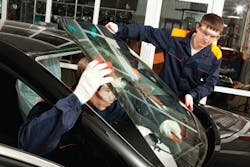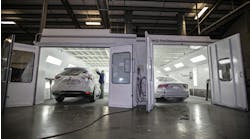When it rains—well, sometimes it hails.
A massive hailstorm ripped through Austin, Texas, in 2009, leaving many vehicles with massive physical damage: Hoods were dented; windshields were cracked. Normally, this would be a business boon for a body shop, but for Dusty Womble, operating partner of Roger Beasley’s Collision Center, the hail wound up putting an enormous ding in his business.
At the time, Womble outsourced all his glasswork to a small, local contractor in the Austin area. When the repair orders piled up following that 2009 storm, though, the contractor was overwhelmed with work; he had too many jobs at too many shops, and there was no way he could get to them all.
Womble and his shop were left out in the rain, so to speak.
“(The contractor) ended up walking out on us,” Womble says, “and we were scrambling to come up with a way to get all these windshields repaired and replaced.
“I told myself I was never going to get caught in that situation again.”
—Dusty Womble, operating partner, Roger Beasley’s Collision Center
Womble and his partners saw this as an opportunity.
In May 2010, they launched Roger Beasley Auto Glass, a five-truck, mobile repair and replacement business based out of Womble’s body shop. Barely two-and-a-half years later, Womble has recouped all of the initial investment costs, and the glass business saw a revenue total of more than $800,000 for 2012 with a net-profit margin above 40 percent.
Joel Timmons is the president of Profitable Glass Solutions Ltd., a company that helps create turn-key glass businesses for collision shops like Womble’s. Adding glass to your collision shop can be a very profitable move, says Timmons, but only if you do it correctly.
Are You Ready For Glass?
In the months leading up to that 2009 storm, Womble says he and his partners had explored avenues to limit the shop’s expenses on outsourcing glass. Each year, glasswork was among the business’s three biggest out-of-shop expenditures.
The storm gave him the push he needed to really explore doing glass in-house.
Outsourcing glass is a cost rather than a money-generating aspect of the company, Womble says. And waiting on an outside company can affect cycle time.
Doing glass in-house was an opportunity for his business to increase profits, but Timmons warns it may not be for everyone.
“Glass needs to be a well-thought-out strategy, not a Hail Mary desperation strategy for a collision shop that’s struggling in their marketplace,” Timmons says. “In other words, don’t go into glass thinking it will bail your shop out.”
Timmons also says that the only way to have glass be truly worthwhile is to create it as a separate but complimentary business at your shop. In other words, it should be its own entity with it’s own P&L; it should generate its own sales, revenues and clients.
“If you’re only doing it to do your own collision glass work, I would suggest you don’t enter the business,” Timmons says. “Typically most collision companies can contract their own glass work out cheaper than they could do it themselves. But, if you’re looking to enter glass to expand your business, then you should explore it.
“The way we usually look at it is if you’re looking to expand your business—your shop is maxed out right now—this is a viable option rather than adding on to your collision shop, which can be very expensive.”
Things to Consider
Timmons suggests talking with other shop owners who have entered the business, networking with consultants and vendors in your area or working with a company such as his to get the basics down first.
If you do find that glass is an option for you, Timmons says to then consider the following items:
Ticket price: Timmons says that glass isn’t something to just “jump into without a thorough plan.” Despite being very similar, glass is a totally different industry with different vendors, networks and insurance requirements.
Scale: The easiest way to look at it, Timmons says, is that if your glass business is successful, it will likely have similar market share to your collision shop. For example, if you’ve got 20 percent of the market for collision work, you can expect 20 percent of the market for glass.
“If you’re working with a market of 100,000 potential customers,” Timmons says, “don’t expect your shop to be able to get 200,000 with glass.”
Really, a lot of the customers are going to be similar, just using different services. Timmons says to carefully analyze for the amount of market share you anticipate reaching, and then create a plan of how big your glass business will need to be to reach that.
Client mix: Womble’s collision shop is part of an automotive group that includes 12 dealerships. Still, he knew that if his glasswork was going to be successful, he needed more than just retail sales. He worked early on to negotiate wholesale contracts with other body shops in the area and secure fleet accounts. In 2012, retail sales only accounted for a third of his revenue (although at higher profit margins due to prices), while fleet and wholesale contributed a third each.
Mobile: Taking your glass business mobile is a double-edged sword, although with one fairly blunt side. Timmons says the vast majority of successful glass companies have a mobile aspect to their business. Womble decided to only have mobile, allowing his shop to get out to customers at any time and finish jobs more quickly. Also, Womble didn’t have to give up or create any shop space for glasswork. When he does glass as part of his collision work, they simply do it in the original bays. All other work is done offsite. The downside is the cost of trucks or vans. Timmons says he sees a mix of clients who choose to buy trucks or lease them; it simply depends on whether the owner wants the vehicles to be a fixed or variable cost to the business. Either way, both Timmons and Womble think mobility is a crucial aspect in making a glass business successful.
Getting Started
Overall, the initial costs are relatively low in starting a glass department, but vary drastically depending on the routes clients choose, Timmons says.
With Womble deciding on the mobile route, he says that his total costs, including a brand-new Ford F-150 extended cab pickup and all the tools, equipment and software needed, was roughly $30,000.
Here are the different items you need to get your glass business started:
Software: Glass has its own parts-numbering system owned by Mitchell Glass, Timmons says, so you need glass-specific software. The companies Timmons works with most are Mainstreet, Quest and GTS. Costs vary, depending on if you choose a company’s server-based or cloud-based system. In-house is a roughly $2,500 one-time investment, Timmons says, whereas cloud-based is closer to $1,000, but often includes additional monthly fees.
People: Timmons says it’s very important to get the best-qualified people you can. Four of Womble’s five glass techs owned their own small glass companies before he hired them. Womble says he looks for two main things in glass techs: good repair and install skills, and their ability to cut laminate glass. He says he had each “try out” by demonstrating their skills before being hired. Salaries are in the range of your mid-level technicians in your collision shop, Womble says.
Training: Even if you have qualified employees, they still need training for the specific products, Timmons says, similar to when you hire painters in your shop. Also similar to painting, many of the glass vendors offer training for their products. Companies like Timmons’s also offer tech training.
Tools/equipment: Shops need a variety of cutting, extracting and installation tools. Also, if choosing a mobile option, it is essential to have very secure toolboxes that protect the tools in transit and against theft. Also, the trucks need to be equipped electrically to run power tools in the field. Overall, both Timmons and Womble estimate a cost of $4–$6,000 for tools and equipment per technician.
Trucks: The choice of your vehicle—and whether you lease or buy—can come down to personal preference, but Womble suggests not cutting corners in this area. “We’re running around with our name on those trucks,” he says. “We have to make sure we’re a good representation of this company as a whole.” That’s why he opted for top-of-the-line trucks and has his techs clean and organize them at the end of each shift.
Quick Return
Womble admits that he miscalculated his market in his initial launch, and that caused the business to grow slower than he wanted it to. Still, he recouped all of his costs and was turning a profit within two years of his initial investment.
Timmons says that it’s typical for shops to reach their ROI goals within 12 to 18 months.
Womble’s collision shop is roughly 38,000 square feet and is on pace for revenue numbers above $6.5 million in 2012. The addition of an $800,000 glass department only adds to that success.
In all, Womble says he’s very pleased with the decision to add glass, and it’s become a fixture of the company’s long-term future.
“If you get into this, you have to be patient, though,” he says. “I mean, that’s the biggest thing: Is it going to turn itself around in three months or six months? Probably not, but if you slow build it and you keep to your plan, you’ll be making money pretty quickly.”




